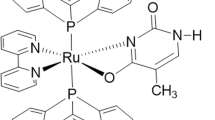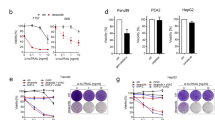Abstract
Tumor necrosis factor-related apoptosis-inducing ligand (TRAIL) has emerged as an attractive cytokine that selectively targets cancer cells, however its efficacy has been challenged by a number of resistance mechanisms. Therefore, the current study investigated the potential of dipyridamole to enhance TRAIL efficacy and the probable underlying mechanisms. Dipyridamole dramatically sensitized p53-mutant human cancer cell lines: SW480, MG63 and DU145, to the antitumor activity of TRAIL, as evidenced by enabling TRAIL to efficiently cleave initiator and executioner caspases. Although dipyridamole upregulated both DR4 and DR5 and increased their cell surface expression, RNA interference revealed a preferential dependence on DR5. Moreover, dipyridamole inhibited survivin expression and its important consequences were confirmed by small interfering RNA. Mechanistically, dipyridamole induced transcriptional shutdown of survivin expression accompanying G1 arrest that was characterized by downregulation of D-type cyclins and cdk6. In addition, a transcriptional mechanism powered by CCAAT/enhancer-binding protein (C/EBP) homologous protein (CHOP) induction was responsible for DR5 upregulation by dipyridamole. Importantly, dipyridamole-induced enhancement of TRAIL efficacy and alterations of protein expression were independent of either protein kinase A or protein kinase G. In conclusion, findings of the present study described novel mechanisms of dipyridamole action and highlighted its promising use as a potential enhancer of TRAIL efficacy.
This is a preview of subscription content, access via your institution
Access options
Subscribe to this journal
Receive 50 print issues and online access
$259.00 per year
only $5.18 per issue
Buy this article
- Purchase on Springer Link
- Instant access to full article PDF
Prices may be subject to local taxes which are calculated during checkout







Similar content being viewed by others
References
Altieri DC . (2003). Validating survivin as a cancer therapeutic target. Nat Rev Cancer 3: 46–54.
Aouad SM, Cohen LY, Sharif-Askari E, Haddad EK, Alam A, Sekaly RP . (2004). Caspase-3 is a component of Fas death-inducing signaling complex in lipid rafts and its activity is required for complete caspase-8 activation during Fas-mediated cell death. J Immunol 172: 2316–2323.
Ashkenazi A, Pai RC, Fong S, Leung S, Lawrence DA, Marsters SA et al. (1999). Safety and antitumor activity of recombinant soluble Apo2 ligand. J Clin Invest 104: 155–162.
Azuhata T, Scott D, Griffith TS, Miller M, Sandler AD . (2006). Survivin inhibits apoptosis induced by TRAIL, and the ratio between survivin and TRAIL receptors is predictive of recurrent disease in neuroblastoma. J Pediatr Surg 41: 1431–1440.
Carlo-Stella C, Lavazza C, Locatelli A, Vigano L, Gianni AM, Gianni L . (2007). Targeting TRAIL agonistic receptors for cancer therapy. Clin Cancer Res 13: 2313–2317.
Clarke WR, Uezono S, Chambers A, Doepfner P . (1994). The type III phosphodiesterase inhibitor milrinone and type V PDE inhibitor dipyridamole individually and synergistically reduce elevated pulmonary vascular resistance. Pulm Pharmacol 7: 81–89.
Fulda S, Debatin KM . (2004). Sensitization for tumor necrosis factor-related apoptosis-inducing ligand-induced apoptosis by the chemopreventive agent resveratrol. Cancer Res 64: 337–346.
Hung KY, Chen CT, Yen CJ, Lee PH, Tsai TJ, Hsieh BS . (2001). Dipyridamole inhibits PDGF-stimulated human peritoneal mesothelial cell proliferation. Kidney Int 60: 872–881.
Kappler M, Bache M, Bartel F, Kotzsch M, Panian M, Wurl P et al. (2004). Knockdown of survivin expression by small interfering RNA reduces the clonogenic survival of human sarcoma cell lines independently of p53. Cancer Gene Ther 11: 186–193.
Kelley RF, Totpal K, Lindstrom SH, Mathieu M, Billeci K, Deforge L et al. (2005). Receptor-selective mutants of apoptosis-inducing ligand 2/tumor necrosis factor-related apoptosis-inducing ligand reveal a greater contribution of death receptor (DR) 5 than DR4 to apoptosis signaling. J Biol Chem 280: 2205–2212.
Kennedy DG, Van den Berg HW, Clarke R, Murphy RF . (1986). Enhancement of methotrexate cytotoxicity towards the MDA.MB.436 human breast cancer cell line by dipyridamole. The role of methotrexate polyglutamates. Biochem Pharmacol 35: 3053–3056.
Li F, Ambrosini G, Chu EY, Plescia J, Tognin S, Marchisio PC et al. (1998). Control of apoptosis and mitotic spindle checkpoint by survivin. Nature 396: 580–584.
Lin J, Jinno S, Okayama H . (2001). Cdk6-cyclin D3 complex evades inhibition by inhibitor proteins and uniquely controls cell's proliferation competence. Oncogene 20: 2000–2009.
Lu M, Kwan T, Yu C, Chen F, Freedman B, Schafer JM et al. (2005). Peroxisome proliferator-activated receptor gamma agonists promote TRAIL-induced apoptosis by reducing survivin levels via cyclin D3 repression and cell cycle arrest. J Biol Chem 280: 6742–6751.
Nakata S, Yoshida T, Horinaka M, Shiraishi T, Wakada M, Sakai T . (2004). Histone deacetylase inhibitors upregulate death receptor 5/TRAIL-R2 and sensitize apoptosis induced by TRAIL/APO2-L in human malignant tumor cells. Oncogene 23: 6261–6271.
Pirnia F, Schneider E, Betticher DC, Borner MM . (2002). Mitomycin C induces apoptosis and caspase-8 and -9 processing through a caspase-3 and Fas-independent pathway. Cell Death Differ 9: 905–914.
Ren YG, Wagner KW, Knee DA, Aza-Blanc P, Nasoff M, Deveraux QL . (2004). Differential regulation of the TRAIL death receptors DR4 and DR5 by the signal recognition particle. Mol Biol Cell 11: 5064–5074.
Rodrigues M, Barbosa Jr F, Perussi JR . (2004). Dipyridamole increases the cytotoxicity of cisplatin in human larynx cancer cells in vitro. Braz J Med Biol Res 37: 591–599.
Saito S, Takahashi S, Takagaki N, Hirose T, Sakai T . (2003). 15-Deoxy-Δ12,14-prostaglandin J2 induces apoptosis through activation of the CHOP gene in HeLa cells. Biochem Biophys Res Commun 311: 17–23.
Salzman EW, Kensler PC, Levine L . (1972). Cyclic 3′5′-adenosine monophosphate in human blood platelets: regulatory role of cyclic AMP in platelet function. Ann NY Acad Sci 201: 61–71.
Sato S, Kohno K, Hidaka K, Hisatsugu T, Kuwano M, Komiyama S . (1993). Differentially potentiating effects by dipyridamole on cytotoxicity of 5-fluorouracil against three human maxillary cancer cell lines derived from a single tumor. Anticancer Drug Des 8: 289–297.
Shiraishi T, Yoshida T, Nakata S, Horinaka M, Wakada M, Mizutani Y et al. (2005). Tunicamycin enhances tumor necrosis factor-related apoptosis-inducing ligand-induced apoptosis in human prostate cancer cells. Cancer Res 65: 6364–6370.
Thompson KL, Sistare FD . (2003). Selection of drugs to test the specificity of the Tg.AC assay by screening for induction of the gadd153 promoterin vitro. Toxicol Sci 74: 260–270.
Van Geelen CM, de Vries EG, de Jong S . (2004). Lessons from TRAIL-resistance mechanisms in colorectal cancer cells: paving the road to patient-tailored therapy. Drug Resist Updat 7: 345–358.
Van Mouwerik TJ, Pangallo CA, Willson JK, Fischer PH . (1987). Augmentation of methotrexate cytotoxicity in human colon cancer cells achieved through inhibition of thymidine salvage by dipyridamole. Biochem Pharmacol 36: 809–814.
Walczak H, Miller RE, Ariail K, Gliniak B, Griffith TS, Kubin M et al. (1999). Tumoricidal activity of tumor necrosis factor-related apoptosis-inducing ligand in vivo. Nat Med 5: 157–163.
Wang S, El-Deiry WS . (2003). Requirement of p53 targets in chemosensitization of colonic carcinoma to death ligand therapy. Proc Natl Acad Sci 100: 15095–15100.
Wieder T, Essmann F, Prokop A, Schmelz K, Schulze-Osthoff K, Beyaert R et al. (2001). Activation of caspase-8 in drug-induced apoptosis of B-lymphoid cells is independent of CD95/Fas receptor-ligand interaction and occurs downstream of caspase-3. Blood 97: 1378–1387.
Wiley SR, Schooley K, Smolak PJ, Din WS, Huang CP, Nicholl JK et al. (1995). Identification and characterization of a new member of the TNF family that induces apoptosis. Immunity 3: 673–682.
Yamaguchi H, Wang HG . (2004). CHOP is involved in endoplasmic reticulum stress-induced apoptosis by enhancing DR5 expression in human carcinoma cells. J Biol Chem 279: 45495–45502.
Yoshida T, Maeda A, Tani N, Sakai T . (2001). Promoter structure and transcription initiation sites of the human death receptor 5/TRAIL-R2 gene. FEBS Lett 507: 381–385.
Yoshida T, Maoka T, Das SK, Kanazawa K, Horinaka M, Wakada M et al. (2007). Halocynthiaxanthin and peridinin sensitize colon cancer cell lines to tumor necrosis factor-related apoptosis-inducing ligand. Mol Cancer Res 5: 615–625.
Yoshida T, Shiraishi T, Nakata S, Horinaka M, Wakada M, Mizutani Y et al. (2005). Proteasome inhibitor MG132 induces death receptor 5 through CCAAT/enhancer-binding protein homologous protein. Cancer Res 65: 5662–5667.
Zhang M, Yang J, Li F . (2006). Transcriptional and post-transcriptional controls of survivin in cancer cells: novel approaches for cancer treatment. J Exp Clin Cancer Res 25: 391–402.
Zhuplatov SB, Masaki T, Blumenthal DK, Cheung AK . (2006). Mechanism of dipyridamole's action in inhibition of venous and arterial smooth muscle cell proliferation. Basic Clin Pharmacol Toxicol 99: 431–439.
Acknowledgements
This work was supported in part by The Japanese Ministry of Education, Culture, Sports, Science and Technology.
Author information
Authors and Affiliations
Corresponding author
Rights and permissions
About this article
Cite this article
Goda, A., Yoshida, T., Horinaka, M. et al. Mechanisms of enhancement of TRAIL tumoricidal activity against human cancer cells of different origin by dipyridamole. Oncogene 27, 3435–3445 (2008). https://doi.org/10.1038/sj.onc.1211008
Received:
Revised:
Accepted:
Published:
Issue Date:
DOI: https://doi.org/10.1038/sj.onc.1211008
Keywords
This article is cited by
-
Enhanced anticancer activity of combined treatment of imatinib and dipyridamole in solid Ehrlich carcinoma-bearing mice
Naunyn-Schmiedeberg's Archives of Pharmacology (2020)
-
Platelet-targeted pharmacologic treatments as anti-cancer therapy
Cancer and Metastasis Reviews (2017)
-
Dipyridamole prevents triple-negative breast-cancer progression
Clinical & Experimental Metastasis (2013)
-
“Combination-oriented molecular-targeting prevention” of cancer: a model involving the combination of TRAIL and a DR5 inducer
Environmental Health and Preventive Medicine (2010)
-
Treatment combinations targeting apoptosis to improve immunotherapy of melanoma
Cancer Immunology, Immunotherapy (2009)



